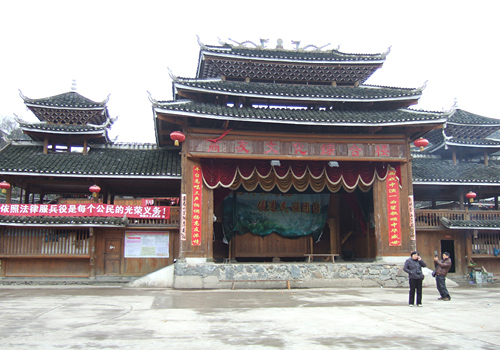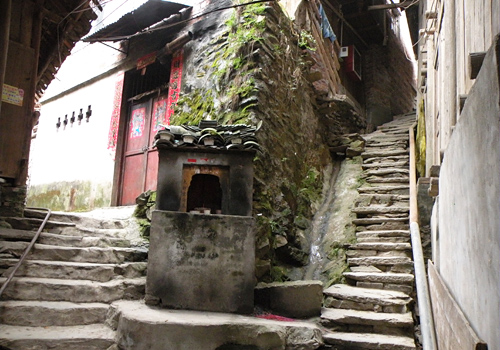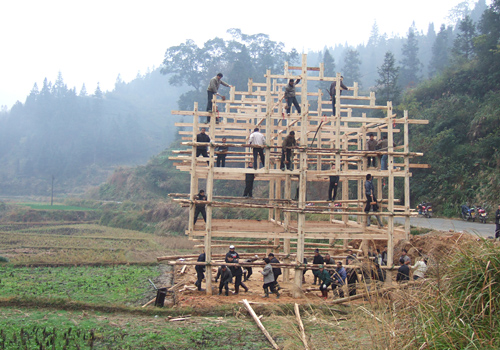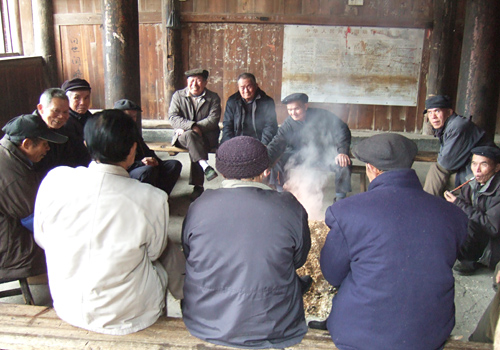A Trip to the Dong Minority Area, Part Ⅰ
2013-01-18China travel Guide
Earlier this winter, four of us took a trip of over one hundred kilometers from Guilin to Sanjiang, a town in the Dong minority county where we spent a few days investigating the area. It was a great trip, which allowed us to explore the original ecological existence and experience the lifestyle of the Dong people. More importantly, we learned more about this ethnic group.
In addition to Sanjiang, we chose to visit three Dong villages, Gaoyou, Gaoxiu and Gaoding. These villages were highly recommended by Ms. Zhao, director of the Ecological Ethnic Museum of Sanjiang County. Owing to her care and guidance, our tour was handled smoothly during those next few days.

Our tour started in the county town of Sanjiang on the first morning. We drove northeastwards, along the River Xun and its tributary, the Linxi River, via the Scenic Area of Chengyang Wind-Rain Bridge. Ms. Zhao was instructing us along the way, sharing her experience about the local conditions and customs of the Dong minority. While we drove along a section of the Linxi River, it being winter, we could see the river’s bottom. There were deep brown pebbles in the riverbed and bamboo waterwheels on the riverside. According to Ms. Zhao, in the past, there had been different kinds of wooden boats on both the Linxi and the Xun River being used mainly as a means of transportation by the locals for cargo and passengers. While listening to her, we looked into the shallow water, which now was no deeper than two feet in the middle. It was hard for us to comprehend what the river had looked like in the past. We can only imagine the scene now in our minds.
After driving a little more than ten km, there appeared on the mountainside, not far from the road, many terraces of tea plantations. The vibrant green tea bushes were sloping with the shapes of those mountains. For the last ten years, tea production has become the main commercial enterprise for the Dong people living on the mountains. Tea leaves can be picked in spring, summer and autumn. The fresh picked leaves are sold to merchants collecting them from one village to the next. Now each Dong family has an income of a few thousand yuan a year from growing tea. It might not be a large amount of money for city people, but it's a very important income for the Dong people who live in this remote area surrounded by huge mountains.

We continued our tour and drove about ten km going through eight villages in Chengyang, then arrived in Linxi, a little township in the mountains. The single road for traffic was built along the small river Linxi, going right through town. On the mountainside cross the river, stands the tallest building in the town. It's the Linxi Middle School, a building made of concrete and bricks, which stands out from the prevailing wooden structures of the Dong villages. In the center of the town, shops of all kinds line up along the main road. Market days fall on the dates with numbers ending with five and zero in each month. If it's a market day, people from the nearby Dong villages come in large crowds, so the town is congested.
We made a right turn after the marketplace, and were ready to go uphill. At this moment, halfway on a slope by the road, we happened to see some Dong people building a wooden house on a terrace. We stopped to visit the building site and talked with some of the people working there. Ms. Zhao could speak their language, the Dong dialect, which made it easy to talk with the locals. Classified as a Ganlan-style building, this type of house is totally built of timber. Furthermore, a house like this would be built without a single nail, using corbel brackets, an ancient architectural construction. Normally the houses are two or three storeys tall. The ground floor is for farming tools or animals, while the people live on the upper floors. The wood being used is fir, growing very commonly in the mountainous regions of China's southwest. It takes at least 20 years for the trees to grow before they are cut for building houses. In China's vast southwest, fir trees are used as good building materials not only by the Dong people, but also by other aboriginals like Miao, Yao and Zhuang.

Leaving the Dong people building the house behind, we were back on the road again. It's a road of merely three meters wide, but truly a pretty good road. After about ten minutes, we came to a wooden village gate of Dong style that caught our eyes. The characters carved on it said it was the gate of the Gaoyou village. As soon as we entered the gate into the village we saw the Wind-Rain Bridge with its distinguishing Dong architectural features. In addition we saw a wooden drum tower of nine storeys standing in the center of the village. Looking around, we noticed that the whole village lies in a valley. Over a hundred Ganlan style houses were built near the mountains, built upon the gradations, forming a spectacular view. We went to the center of the village, and came upon a drum tower. Nearby, a sign on an old building attracted us. The building housed the Elderly's Recreation Center.

We pushed the door open and found more than a dozen old men sitting around a fire to stay warm and chat. The firewood they were burning was the leftover timber they had used for building houses. It was so smoky because some of the burning material was not quite dry. The old men ranged in ages from sixty to well over eighty years old. These seniors often gather to enjoy their happy time together talking (in the Dong dialect) as way to keep themselves from feeling lonely. Some of them were holding long tobacco pipes and smoking in an interesting way. That really caught my attention. Out of curiosity, I went to sit by one of them and touched his pipe with my fingers. It was a bit shiny and darkened by smoke. "My respected senior, may I know what material this tobacco pipe is made of?" He handed the pipe over and said: "It's made of the roots of the mountain bamboo." I spent a while checking it out. There were many segments of only about two centimeters long, with swollen joints in between. "How did you get through the joints in the middle and turn it into a tobacco pipe?" "That's easy. I just used a tool to break through the middle." He answered with a smile. I had a look at the little bowl on the end of the pipe and asked him again: "Do you have to cut your tobacco leaves into pieces before you smoke?" He smiled spontaneously, "No, I don't have to do that, for I can manage by just putting it into that hole." As he was talking, he took crumpled leave out of his pocket. It was brown color and slightly bigger than the palm of your hand. He tore some off and stuck it into the bowl of the pipe. He looked satisfied to smoke when lighting it.
--- VisitOurChina




